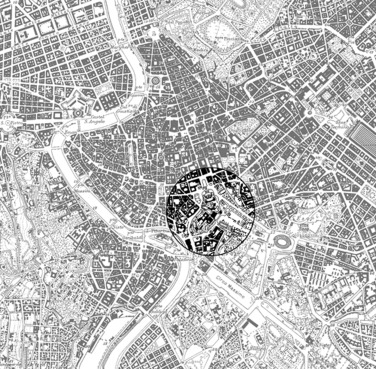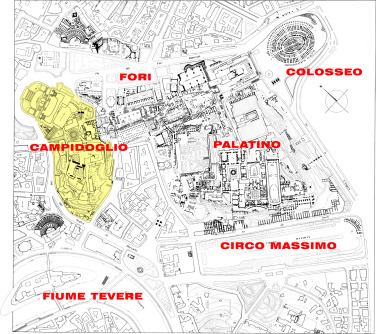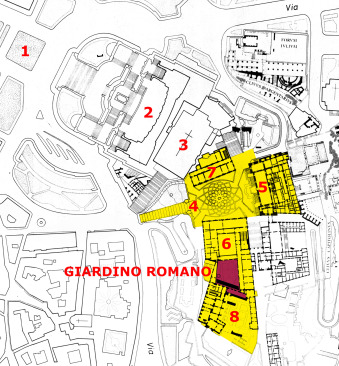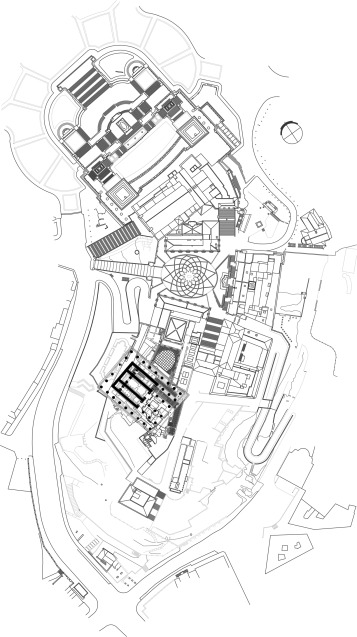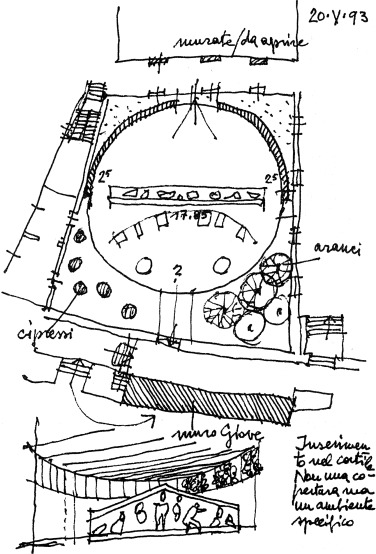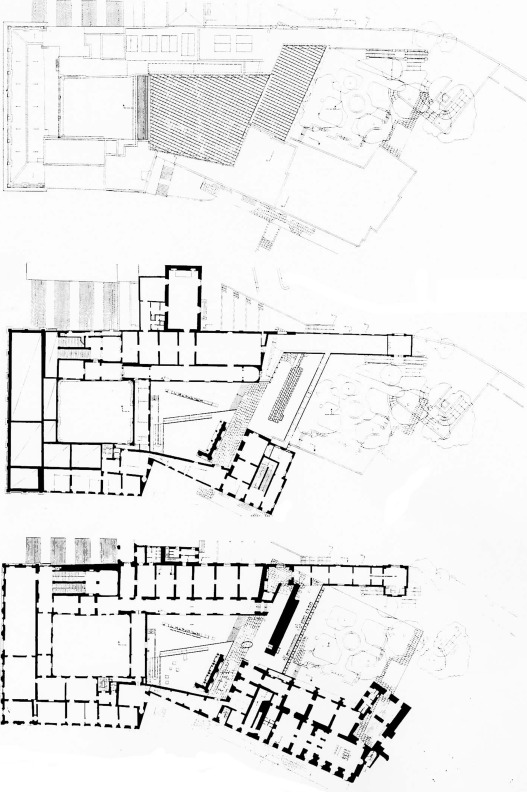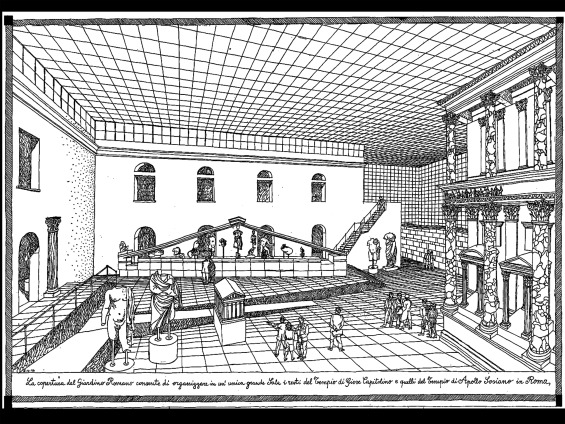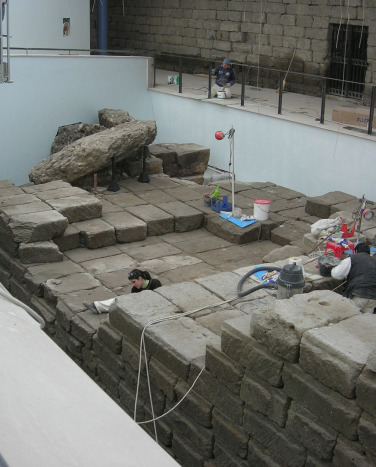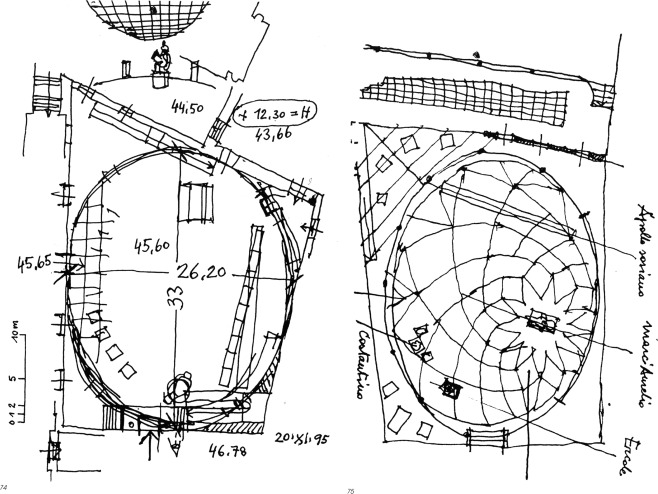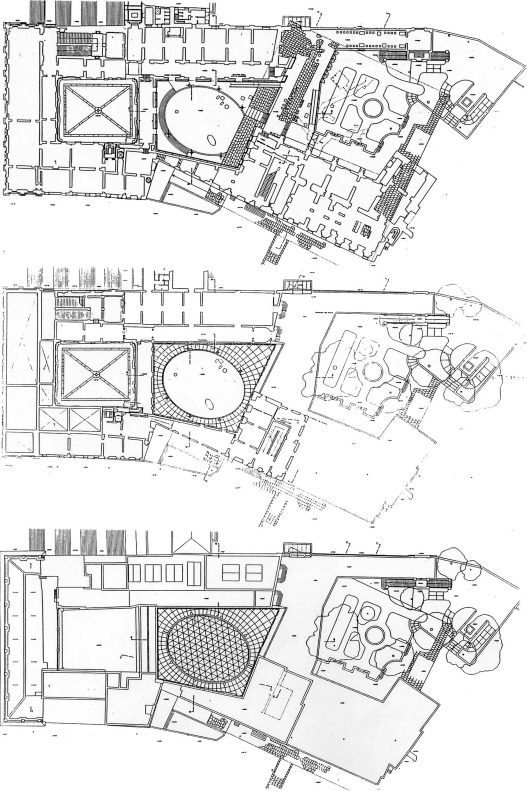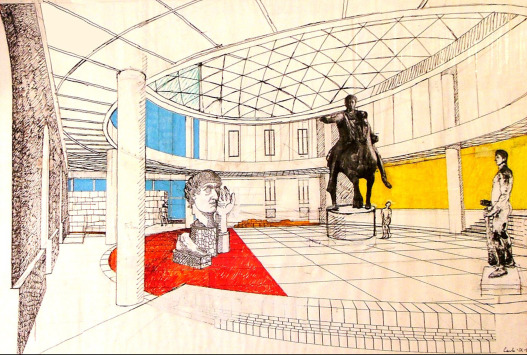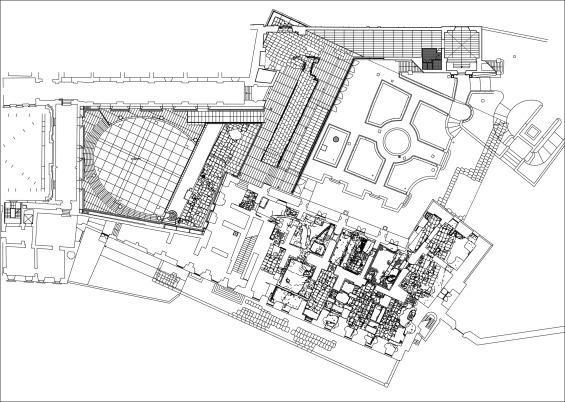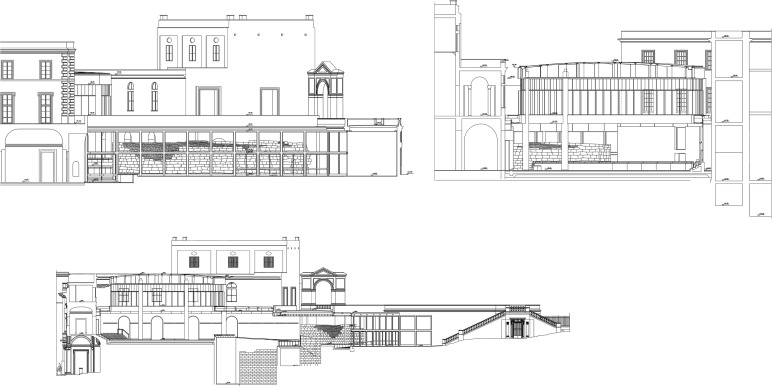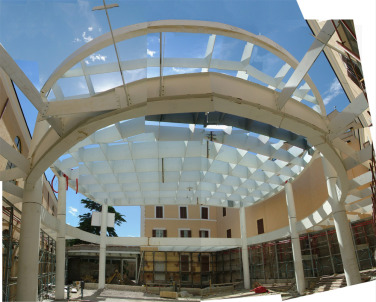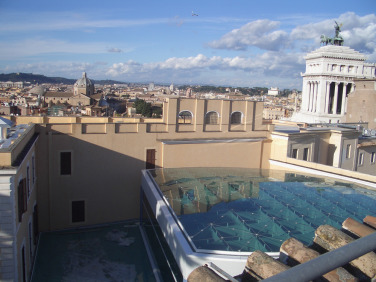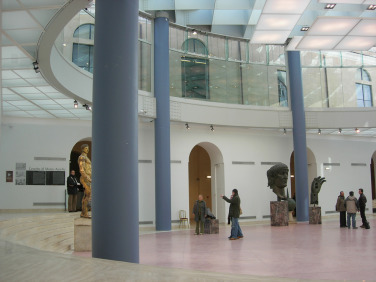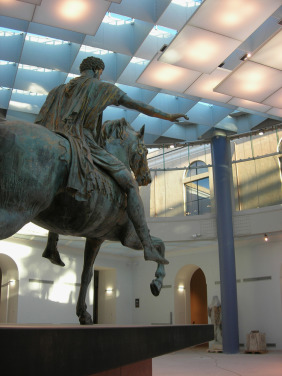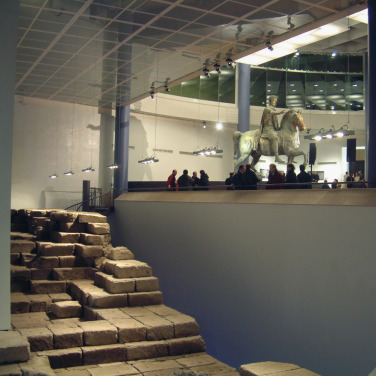Abstract
The new Hall of Marcus Aurelius in the Capitoline Museums, located within the ancient site of Giardino Romano, displays the original statue of the Roman emperor of the 2nd century AD. The idea of extending the Capitoline Museums by including this site came about in the framework of its general redevelopment.1 The new Hall is the result of a long and complicated process (1988–2005) considering the exceptional importance of the site and the many changes brought to the museum programme during the said period (Figure 1 ; Figure 2 ).In fact, the new Hall was originally supposed to display the marbles of the Temple of Apollo Sosianus, the foundation wall of the Temple of Capitoline Jupiter, embedded within the structures of the Palazzo Caffarelli, opposite the Giardino Romano. However, in 1997, the plan for the Capitoline Museum changed radically as the statue of Marcus Aurelius, which had been restored following the blast of a bomb attack in 1979, was determined to be the focus of the Hall. The project finally consisted of a steel and glass structure on an elliptic plan andshaped around the foundations of the Temple, with the statue at its center.
Keywords
Capitoline Museums ; Temple of Apollo Sosianus ; Equestrian statue of Marcus Aurelius ; Temple of Capitoline Jupiter ; Costantino Dardi ; Carlo Aymonino
1. Introduction
The new Hall of the Capitoline Museums, also called the "Hall of Marco Aurelius,” displays the original equestrian statue of the Roman Emperor.2 This hall is located at the ancient site of the former Giardino Romano (Roman Garden). This open space has served as a garden since the first decades of the past century. It is located at the rear of Michelangelo׳s Palazzo dei Conservatori and is the result of a sequence of additions. The site includes part of the Palazzo Caffarelli3 , which today flanks the hall on two sides, with a wing extending to the southeast along the via del Tempio di Giove and serving as the stables of the Palazzo.This hall also borders a free area that is used as a garden (Figure 3 ).
|
|
|
Figure 1. Rome׳s Central Archaeological Area, the most extensive site included in a contemporary urban context in the world. At the foot of the Capitolium , the Fora iscomposed of the Forum Magnum , dating back to Pre-Republican and Republican Rome, and of the Imperial Fora. Further is the Palatine with the Imperial buildings, the Circus Maximus , the greatest stadium in the ancient world hosting 300,000 spectators, and the Coliseum. |
|
|
|
Figure 2. The Capitolium represents the first and most symbolic geographical center of Rome: north of the Capitoline Hill, the Renaissance district was erected, with further Baroque densification of the urban fabric; to the south is the vast archaeological area with, in clear evidence, the Coliseum. |
|
|
|
Figure 3. Michelangelo׳s Capitolium with the three main buildings and the renown piazza (in yellow): the Palazzo dei Senatori, which hosts the headquarters of Rome׳s Municipality (5), the Palazzo dei Conservatori, built on the foundations of the Temple of Capitoline Jupiter and hosting the main and most famous halls of the Capitoline Museums (6), and the Palazzo Nuovo, which is now part of the same museum. At the center are the piazza designed by Michelangelo and the staircase connecting the complex to the city. Adjacent to the Palazzo dei Conservatori is the Palazzo Caffarelli, today a part of the Capitoline Museum and, between the two, the so-called Giardino Romano (in red), where Carlo Aymonino׳s project is located. Behind the Palazzo Nuovo is the Basilica of S. Maria Aracoeli, and down the slope, the ‘Vittoriano’ (2), a monument to Italy׳s first king Vittorio Emanuele II, built between the end of the 1800 and the beginning of the 1900. The Capitoline Hill is highly representative of the historical continuity of Rome׳s political powers, given that it merges the symbols of the central government (Vittoriano), the Church (Basilica of S. Maria Aracoeli) and the Municipality (Palazzo Senatorio). |
The hall is the result of a complicated design process that was begun at end of the 80s and that lasted for 17 years (Musei, 2000 ; Musei Capitolini, 2006 ). The programme initially aimed at the general rehabilitation of the entire Capitoline Museums to showcase artifacts of extraordinary value, which needed an organic reorganization throughout a set of strategic works. Architect Costantino Dardi4 participated in the first step of the design process. However, the second phase shifted the focus to the restoration of the Giardino Romano for exhibition purposes.
In the framework of the research and of the proposals developed during these years, the idea of using the site of the Giardino Romano as an exhibition space was proposed based on the old and unsuccessful idea of Rodolfo Lanciani. Lanciani proposed reshaping the site into a closed space and lit from above for exhibitions of exceptional importance. Before dying in a car accident in 1991, Costantino Dardi had time only to sketch some perspectives that showeda coffered glass-ceiling shed over a large portion of the garden.
Carlo Aymonino resumed Dardi׳s project and completed the work in 2005. The length of the entire operation may seem longer than even the average length of great projects conducted in Italy in the past decades. However, the facts and events that influenced its implementation cannot be overlooked. The exceptional historical and artistic importance of the site, the Capitolium , which symbolizes the founding of Rome, is renowned for its world-famous piazza designed by Michelangelo with the equestrian statue of Marcus Aurelius, its famous staircase that slopes down to the city, and the three buildings that impress the viewer by the magnificence of the site. 5 The historical and architectural importance of the site has obviously marked the operation with great caution and also strong opposition against the idea of transforming the ancient Giardino Romano into a closed hall (Aymonino 1997a , 1997b , 1998 ).6
Events grew complicated as further changes in the museum programme were effected and were abruptly impacted by a traumatic episode in Rome׳s and Italy׳s history: a bombing attack on the Capitoline Hill at the end of the 70s. This event influenced the decision to shelter the equestrian statue of Marco Aurelius7 in the new Hall, which changed the organization and the architectural design of the museum despite the implementation process that was underway. On the other side, no questions were raised around the inclusion of the archaeological remains within the site. These remains contributed to retracing the history of the site, such as bringing to light a section of the foundation walls of the Temple of Capitoline Jupiter. Excavation works, which should have been initiated ten years earlier to establish whether or not the intervention was a feasible option, began only in 2000.
In any case, without the resolution of Anna Mura Sommella, Director of the Capitoline Museums, and of Eugenio La Rocca, Head of the Municipal Superintendence, along with the heartfelt commitment of Carlo Aymonino, one of the most important Italian architects of the last century, the extension of the Capitoline Museums would never have been achieved. Along with the municipal administration, these people have managed, each through their own role and hard work, to facilitate consensus among policy makers, cultural realms, and public opinion, which are all necessary to any form of progressive public initiative in Italy.
2. Premises of the design work and Costantino Dardi׳s solution
In the early 1990s, the Giardino Romano was a bare space with no outstanding feature. It was located 6.60 m above the adjacent courtyard of Michelangelo׳s Palazzo dei Conservatori, on the northern side of the Capitolium . The garden was accessible from the first floor of the Palazzo from the hall of Horatii and Curatii and from the hall of the Castellani Collection, and today from the Galleria degli Orti. The garden borders Palazzo dei Conservatori on two sides: along the rests of the Palazzo Caffarelli and along the passageway leading to its stables. The passageway includes one of the three foundation walls of the Temple of Capitoline Jupiter, which is the only part that is standing free ata height of approximately 4 m. The passageway and the long wing of the stables form an “L”that surrounds a beautiful garden, which is the Giardino Caffarelli.8
However, at the time, the Giardino Romano served as the pivot of the new irregular trapezoidal plan, with its southern side bordering the remains of the Palazzo Caffarelli and its passageway leading to the stables. Such geometric irregularity hides a historical continuity as shown by the stratigraphy of the site. This side of the Palazzo Caffarelli is, in fact, aligned with the foundation wall of the Temple Capitoline Jupiter, as reported in Lanciani׳s map and highlighted during the recent excavations coordinated by the Archaeological Superintendence (Figure 4 ).Given this finding, the southern side of the Giardino Romano attained strategic importance in the design of the new Hall of Marcus Aurelius.
|
|
|
Figure 4. Zenithal plan of the Capitoline Hill, representing Aymonino׳s plan for the new Hall of the Capitoline Museums on the site of the Giardino Romano, placed slightly southward of the Palazzo dei Conservatori, with a reconstruction of the plan of the Temple of Capitoline Jupiter by the same architect. |
The Giardino Romano was at the beginning an open space with orange and cypress trees and was then unexpectedly transformed into an exhibition area in the 19th century. In 1876, a glass and wooden octagon-shaped, floreal-style pavilion was designed by the architect Virgilio Vespignani to showcase the marbles brought to light during the construction of the new districts of Rome, which had then become the capital of the new Italian state.9 This pavilion had a central role during the redevelopment into a museum of the Palazzo dei Conservatori, which was the previous seat of the municipal judiciary. However, Vespignani׳s pavilion was demolished in the early 20th century in view of an ambitious renovation plan promoted by Rodolfo Lanciani, who had envisaged extending the Capitoline Museums byreshaping this space into new exhibition halls lit from above. The project was never achieved because of the lack of financial resources. Thus, without the pavilion, the courtyard was re-organized as a garden and, on Lanciani׳s initiative, the original Forma Urbis Severiana was displayed on its Northern wall. 10
The Palazzo Caffarelli suffered the same fate of Vespignani׳s pavilion, albeit worse, as the structure was abandoned by the Prussians at the end of the First World War and then destined for demolition to bring the remains of the Temple of Capitoline Jupiter back to light. This overtly ambitious plan was unsuccessful and caused the destruction of valuable architectural structures. In 1924, the Palazzo Caffarelli was purchased by the Italian government, which decided to spare the wing leading to the Palazzo dei Conservatori from demolition.11
Carlo Aymonino dedicated much effort to include the temple within the landscape of the Capitolium while designing a new solution. Between the 1990s and the first decade after year 2000, the design for a new Hall on the site of the Giardino Romano had a two fold intent that affected the implementation of the project.
Most Italian museums lack suitable halls for large statuary given that they are often created within historical buildings and are originally meant for different functions. As mentioned, the Palazzo dei Conservatori previously housed the Magistracy. Therefore, the idea of achieving a great hall in the Giardino Romano and placing great and huge marbles in the hall seemed very inviting. The first idea then was to display the pieces of the Temple of Apollo Sosianus12 , which was temporarily exhibited at the Palazzo dei Conservatori in 1985.
The exhibition programme, which is an integral part of the redevelopment of the Capitoline Museums, was entrusted to Costantino Dardi, who started working in the early 1990s but passed away soon after. Aymonino became Dardi׳s inevitable successor because of his professional prestige, capacity as Councillor of Rome׳s Historic Center, and experience in the redevelopment project of the Capitoline Museums. The “Great Capitoline Hill Project” envisaged to transform the Capitolium into a museum given that many of its buildings formerly housed administrative offices that appeared out of place in view of the historical and artistic importance of the site. 13
3. Modifications to the display programme and Carlo Aymonino׳s first project for the new Hall: 1993–1995
The first group of sculptures to be displayed in the new Hall consisted of the awesome marbles of the Temple of Apollo Sosianus. Today, three beautiful columns of the Temple, which are placed on their podium and surmounted by the corner of the entablature, have been recomposed and are placed next to the Theatre of Marcellus, opposite the Capitolium . Similar to most places of worship in ancient Rome, the temple consists of reconstruction dating back to Augustus׳ age of various buildings dedicated first to Apollo and then to Diana. The present name of the structure comes from that of its final rebuilder, Gaius Sosius, who conducted the reconstruction in 30 BC. The building was marked by an outstanding combination of ancient and modern styles, reuse of precious marbles for the cell, and imported Greek sculptures of the 5th century BC for the pediment.
Thus, the initial decision was to place the statues of the pediment in the new Hall, along with other marbles. The idea was to display the statues in their original position in accordance with archaeological reconstructions, within a one-to-one model of the ancient pediment at approximately 15 m long.
In May 1993, Aymonino started working on the design of a circular plan tangential to the southern side of the Palazzo dei Conservatori, with a glass wall facing Palazzo Caffarelli: “not a shed but, rather, a dedicated space,” he wrote describing his first project (Figure 5 ). The pediment of the Temple of Apollo Sosianus was to be placed at the center of the hall, parallel to the Palazzo dei Conservatori, to be immediately visible to visitors coming from the Capitoline Museums, or else, placed in the opposite direction to be gradually perceived by those walking around it.14 However, that initial project, which was based on a strong idea and in perfect harmony with its architecture, was soon discarded. Instead, it was decided to place a significant portion of the Temple׳s cell near the marbles of the pediment, reassembled to reproduce the original artifact. The presence of this second artifact implied a radical re-evaluation of the first project owing to its dimensions (15.65 m high and approximately 7 m wide) and its strong visual impact.
|
|
|
Figure 5. Carlo Aymonino׳s first solution to the new Hall in the Giardino Romano, with the arrangement of the pediment of the Temple of Apollo Sosianus. |
In addition to this structure, the equally important presence of the foundation walls of the Temple of Capitoline Jupiter, embedded in the passageway linking Palazzo Caffarelli to the stables, was to be considered. The curvilinear hall had to be replaced by a higher and larger room to make this wall fully visible and to ensure the correct balance between the elements of the Temple of Apollo Sosianus and the foundation walls of the Temple of Capitoline Jupiter.
Moreover, long before the excavations were conducted, it became evident that the first foundations on the northern side of the Temple of Capitoline Jupiter stood under neath underneath the façade of the Palazzo Caffarelli, facing the Giardino Romano. Thus, the area could not be altered in any way. Aymonino then designed a hall that occupied all available space, much similar to Dardi׳s initial design. The design focused on its roof and the shape of its plan and divided the hall into two parts. The first part was at the level of the foundation walls of the already uncovered parts of the Temple of Capitoline Jupiter. Thus, the lower portion was to host the cell of the Temple of Apollo Sosanius. The second part was at the level of the Galleria degli Horti and was designed to host the pediment of the Temple of Apollo Sosianus (Figure 6 ).
|
|
|
Figure 6. Down to top: plans for the first, second, and roof levels of the new Hall of the Capitoline Museums during the first phase of the project (1993–1995). On the left is the Palazzo dei Conservatori; on the right the Palazzo Caffarelli; at the center the new Hall disposed on two levels. The upper one hosts the reconstruction of the pediment of the Temple of Apollo Sosianus, the lower one the recomposed cell of the same Temple and the foundation of the Temple of Capitoline Jupiter, whose traces can also be found inside the passageway connecting the Palazzo Caffarelli to the stables. The drawing also shows the position of the underground foundation wall of the Temple of Capitoline Jupiter. |
This solution suggested that the architect׳s intention was to separate the statues from the architectural findings brought to light in the area, and from those moved here from the Temple of Apollo Sosanius. A system of ramps was intended to connect the three levels: the passageway, the Galleria degli Horti, and the wing of the Palazzo dei Conservatori. The first two levels were to be connected by a large stair ramp. Aymonino׳s layout indicated the exact location of the foundation walls of the Temple of Capitoline Jupiter before these walls were unearthed. The architectural solution also envisaged raising a story of the stables׳ wing to extend the Picture Gallery and construct a balcony opposite the new Hall connected to the Palazzo Caffarelli. The proposed structure was designed to protect the elevation wall of the Temple. In functional terms, a circular movement was therefore created around the different areas at the first floor of the Capitoline Museums. In architectural terms, the platform served as a frame around the new structure, which housed the foundation walls of the Temple of Capitoline Jupiter.
Undoubtedly, the entire area of the new Hall was to be covered with a roof. Aymonino was almost obsessed with this task, which must have been particularly challenging to him, as indicated by the dynamism of solid shapes in his plan. He was aware that such architectural element had to be neutral, but he did not resort to a solution based on technology (e.g., a curtain wall), nor to assembling strategies, perfect joints, transparency of glass plates, and thermal insulation: Aymonino was not Norman Foster.
Finally, he devised a 1×1×1 m3 steel coffered roof, enclosed by glass panels. This shed would have covered the entire area of the Giardino Romano, crossing over its walls, embracing the corner of Palazzo Caffarelli (i.e., following the alignment of the underground foundation), all the way down to the lower level of the room hosting the ancient wall, and closing up as a façade onto the Giardino Caffarelli. Nonetheless, this project remained unachieved because the redevelopment plan of the museum was again changed (Figure 7 ).
|
|
|
Figure 7. Carlo Aymonino׳s perspective of the final solution to the first phase of the project. On the right stands the reconstruction of the cell of the Temple of Apollo Sosianus, in the middle, the pediment with the original statues, and in the background, a foreshortening of the remaining wall of the Temple of Capitoline Jupiter. A steel-and-glass coffered ceiling covers the entire void of the old Giardino Romano. |
4. Second phase of the process from the design of an exhibition hall to the arrangement of an archaeological shed: 1995–1997
Aymonino himself considered the above-mentioned design as the “first phase” of the project (Morelli, 2002 ). Some noticed a radical turnover in the museum׳s architectural concept between the first and the last series of the drawings. In fact, it was not only a question of creating an exhibition area in which to display precious ancient relics; rather, the purpose of the museum was to enhance the specific features of the site, renouncing its own distinctiveness. The museum is the invention of an exhibition space for unpredicted objects in the best conditions of visibility, light, and environment. In the case of the Giardino Romano, the plan slowly became the arrangement of an archaeological area, which essentially led to the design of an architectural envelope. This situation was similar to the case of many artifacts and archaeological sites where protection from atmospheric agents is paramount.
The project was not approved by the National Commission for Cultural Heritage because the steel and glass roof were considered “excessive,” and the stables of Palazzo Caffarelli had to be raised to a certain height. A set of adjustments could be brought to the project, but the situation again changed drastically because the new Hall was now bound to house the statue of Marcus Aurelius, as well as the sculptures on the pediment of the Temple of Apollo Sosianus, at least for a short time. Thus, the project entered its second phase, marked by a set of further changes.
The statue of the famous emperor Marcus Aurelius was, in fact, the centerpiece of Michelangelo׳s piazza on the Capitolium . In 1538, Pope Paul III moved the statue here from S. Giovanni in Laterano (i.e., the basilica of S. John at the Lateran) where it stood for centuries and was miraculously preserved in the erroneous belief that it depicted Constantine, a very dear figure to the Church of Rome. The Pope entrusted Michelangelo with the design for a new appropriate location of the statue. In 1539, the Maestro placed it at the heart of his composition for the Piazza on the Capitolium . Hence, the statue became its symbol, beloved and respected by Romans and visitors from all over the world. The situation remained unvaried until the tragic bomb attack, which was related to the “strategy of tension” 15 that was conducted on the night of April 29, 1979 upon the Capitolium , the seat of Rome׳s Town Council. The attack was an outrage to culture and an intimidation against the city׳s left-wing administration. The explosion damaged the Palazzo Senatorio and the pedestal of the Marcus Aurelius. The damage was thoroughly investigated. Damage on the equestrian statue was seen in light of the most fragile element of Michelangelo׳s composition. The accurate assessment revealed cracks on the horse׳s legs and widespread deterioration; thus, restoration was needed. The statue was removed from the Piazza in January 1981 and brought to the laboratories of the Istituto Centrale del Restauro (ICR). Restoration works lasted seven years, which is considered an “eternity.” Thus, comments, such as the Marcus Aurelius had been kidnapped to strip it away from Rome׳s municipality, were heard.
Crucial years passed by, and the debate on “what to do” with the Marcus Aurelius and his horse mounted. The absence of the statue from the piazza was widely perceived as a painful loss, which altered, among others, Michelangelo׳s project.16
Finally, in 1991, the Marcus Aurelius was returned to the Capitolium and was placed in the new museum, following the decision of the ICR that the statue cannot bear exposure to open air. The idea of making a copy of the statue and of replacing the original in the piazza was considered. 17 Once the copy was completed, no other option was left other than placing the replica on the pedestal at the center of the piazza. Little was done to make the copy more similar to the original statue. In the copy, the patina and golden coating of the original were simulated. However, although the copy is well tolerated by tourists, the Romans disdain the statue. We cherish the belief, in the hope of being wrong, that the copy is poorly appreciated by those who have in mind the original, given that copies should not be mistaken for the original according to the principle of uniqueness of a work of art.
Years after, in 1997, it was then decided that the original equestrian statue of Marcus Aurelius was to be placed in the new Hall of the Capitoline Museums, while the design of the structure was still underway. Aymonino was informed of the decision and was therefore obliged to modify the project accordingly. Soon after, the intent to extend the archaeological inspection to the entire site was also taken, but three years elapsed from the decision to place the Marcus Aurelius in the new Hall to the beginning of the archaeological inspection, which, albeit, was necessary to ensure targeted funding. Clearly, the Giardino Romano and its adjacent buildings, notably the Palazzo Caffarelli or what remained of it, represented the highest area of the Capitolium . The discovery of the relics of the Temple of Capitoline Jupiter, previously guessed by Rodolfo Lanciani, allowed the understanding of the entire history of the site and its connections to the birth of Rome. The excavations that began in 2000 brought to light traces of the settlements dating back to the Bronze Age, 14th century B.C., and other periods. The excavation bore witness to the thousand-year-long use of the hill, which included traces of the 6th century BC building site of the Temple of Capitoline Jupiter and some tombs. 18
Most important, the archaeological excavations brought to light the northern foundation walls of the Temple beneath the facade of the Palazzo Caffarelli. The foundation was aligned, as Lanciani had envisioned, with the slanted side of the court. The huge structure, 4.30 m thick, crosses the southern side of the Giardino Romano, passes beneath the Galleria degli Horti wing, and appears for less than 1 m along via del Tempio di Giove in correspondence with the southeastern corner of the Temple׳s podium. Considering the archaeological findings on the opposite side, the wall was approximately 62 m long. The location on the site of the Temple׳s walls, notably its northern walls, was already known, but not its dimensions and the exact location of its foundations, which were then discovered to be more than seven metres below the level of the Giardino Romano. Considering the elevation of the foundation walls, featuring the springer blocks of the barrel vault that connected the six transversal foundation walls, as well as the difference between the level of the Giardino Romano and that of the passageway, the foundations of the Temple of Capitoline Jupiter were approximately 15 m tall and supported a slab wider than 3.000 m2 .19 Compared with the famous Parthenon in Athens, the Temple of Capitoline Jupiter, which is 100 years older, covers an area that is1000 m2 wider and is of a completely different type, which is the Etruscan and Italic one, rather than a square where the side parallel to the cell is only 9 m longer than the perpendicular one.
The unearthing of the wall was a sensational discovery and led to major expectations, as a trench on the northern front was opened for the purpose of analyzing its structure and depth. The wall had over 20 layers of blocks in cappellaccio (i.e., a local tufa stone), which was perfectly laid out and placed approximately 7 m underground (Figure 8 ).
|
|
|
Figure 8. A view of the first foundation wall of the Temple of Capitoline Jupiter brought to light during the restoration works of the Giardino Romano. In the background is the second foundation wall, almost entirely preserved. The quality and the regularity of the tuff blocks, worked out on the upper part to be regularly disposed without breaks, is amazing and is more appropriate to the structure of the elevation walls rather than to the foundations of the Temple. |
The time that elapsed between the decision to place the equestrian statue of Marco Aurelius and the unearthing of the foundation walls of the Temple of Capitoline Jupiter prompted Aymonino to reconsider his projects. The question was no longer a matter of finding a neutral setting for a relevant monument (i.e., 4.30 m tall and 4 m long, not counting the pedestal), but to shape the space around it to recall the Capitolium designed by Michelangelo.
Without regret, Aymonino abandoned the idea of the glass shed covering the entire space of the “Giardino Romano,” as well as the space around the foundation walls of the Temple of Capitoline Jupiter, and returned to study a volume in the ancient Giardino Romano with an independent shape. The new space would have had an elliptical plan that recalls the shape of Michelangelo׳s piazza; accordingly, the equestrian statue of Marcus Aurelius was to be placed on one side, although finding a central position within the design of the flooring (itself recalling Michelangelo׳s design). The elliptical metal-and-glass shed was to be supported by 20, later reduced to six, 75 cm-diameter sheer steel pillars, without capitals and bases. Its architectural features would have been different, given that it would have been enclosed within a sturdy steel ring hinged to the pillars (Figure 9 ; Figure 11 ). However, this solution clearly highlighted the symbolic role of Marcus Aurelius within a perfect and enclosed space but overshadowed the two foundation walls of the Temple of Capitoline Jupiter. Aymonino thus included in his project the conservation of the trench that had unveiled the wall, thereby allowing its complete view and showcasing its magnificence. But such space, so unbalanced with regard to such precious finding, left uncertainties. In a powerful and ingenious decision, Aymonino recurred to a design device intended as a “creative mistake” and cut the elliptical plan in correspondence with the trench. Finally, he shaped the access to the trench excavated along the wall and placed it in full view. The trench is 8.14 m deep, and direct access is provided by a beautiful iron spiral staircase (Figure 10 ).
|
|
|
Figure 9. Carlo Aymonino׳s sketches for the new Hall intended to display the statue of Marcus Aurelius and the pediment of the Temple of Apollo Sosianus during the second phase of the project (1997–2002). |
|
|
|
Figure 10. Top to down: plans of the first floor and roof of the new Hall for the statue of Marcus Aurelius. The upper drawing shows the final solution, with the ellipse cut according to the foundation wall of the Temple of Capitoline Jupiter found during the archaeological excavations. |
|
|
|
Figure 11. Carlo Aymonino׳s perspective of the new Hall with the equestrian statue of Marcus Aurelius, before the archaeological excavations that brought back to light the foundation wall of the Temple of Capitoline Jupiter. |
At this point, the co-presence of the wall and statue produced an architectural balance. The elliptic shape was strong enough to support the polarity of the equestrian statue of Marcus Aurelius, but the cut, closed up by a screen of glass panes, highlighted the presence of something important related to the trench. In the background stood the foundation walls of the Temple of Capitoline Jupiter, which completed the architectural experience.
As one enters the Hall, the sight is breathtaking because the ancient wall may be discovered in its full magnificence only when approaching the trench. Moreover, the “drum” emerges from the lower roof of the space between the ellipse and the walls of the Giardino Romano. Nonetheless, the walls of the ancient garden are not visible when standing in the Hall, given that they are veneered to house the installations and the load-bearing steel pillars supporting the glazed slab (Figure 12 ; Figure 13 ).
|
|
|
Figure 12. The final solution with the elliptical roof cut along the edge of the trench of the foundation wall of the Temple of Capitoline Jupiter. The drawing also shows the traces of the foundation system of the Temple found during the archaeological excavations in the rooms of the groundfloor of the Palazzo Caffarelli. |
|
|
|
Figure 13. Top left: the elevation of the new Hall from the Giardino Caffarelli. Foreground: the portico hosting the foundation walls of the Temple of Capitoline Jupiter with a foreshortened view of the roof drum of the Giardino Romano. Top right: the transversal section of the new Hall. Bottom: the longitudinal section from Palazzo dei Conservatori to the Giardino Romano and the stables of the Palazzo Caffarelli. Foreground: the trench with the relics of the foundation of the Temple of Capitoline Jupiter. |
5. The final project for the new Hall of the Marcus Aurelius: 1997–2002
The details of the project could then be further developed based on Aymonimo׳s idea (Pitzalis, 2000 ; Pitzalis and Hansen, 2000 ). The elliptical shape is perceived in relation not only to the roof but also to the pavement, which is about 90 cm lower for three quarters of the projection of the roof, forming a sort of cavea , or piazza, surrounded by six-step stairs for most of its perimeter, which bring it to the same level of the adjacent halls of the Palazzo dei Conservatori. The rest of the Hall is on the same level as the “Galleria degli Horti” and opens into it through three great arches. The design inspired by Michelangelo׳s Capitolium had disappeared, given that it was no longer compatible with the cut of the Hall in relation to the foundation walls of the Temple of Capitoline Jupiter and the flooring had been replaced by a “battuto alla veneziana” (i.e., traditional venetian paving made of stone and mortar) in “rosso antico” colour (i.e., ancient red). The new piazza and the colonnade protecting the Temple׳s second foundation walls, placed on two different levels, were then connected with an elegant catwalk, 14.40 m long and 2.50 wide, from which one may admire the width and height of the first foundation wall of the Temple of Capitoline Jupiter. Changes were also effected both on the loadbearing structure and the roof of the passageway, which contained the elevation wall of the Temple of Capitoline Jupiter. This consisted of steel pillars, with a diameter of 20 cm, which were also to support the roof slab, thereby ensuring a full view of the upper portion of the ancient wall and providing spatial continuity with the terrace of Palazzo Caffarelli.
The roof of the elliptical part of the Hall remained a coffered steel structure, with 1.94-cm-widebays (i.e., twice that of the original dimensions), and washeld together by a massive edge beam. The roof is 12.40 m from ground level, but it is not flat. It consists of a lenticular surface composed of ground waters with a height of 54 cm to facilitate the drainage of rainwater. Each coffer is made up of four triangular windowpanes fastened at the vertex with sealants and gasket to prevent expansion caused by summer heat. At the approximate height of 5.5 m, a second beam binds the pillars together and supports the glazed floor-slab covering the space between the elliptical dome and the walls of the ancient Giardino Romano. These are veneered with panel frames that leave space for the installations. The curved surface between the first and the second beams is also glazed with a double panel system: the upper one consists of automated brise soleil and the lower one is composed of wide laminated glass panels. The system is visible from the terrace of the Palazzo Caffarelli, which juts over the portico and stables. Huge steel and glass portals complete the arcade opening into the Giardino Caffarelli.
In the meantime, the second foundation wall embedded within the passageway between the Palazzo Caffarelli and the stables also underwent restoration, thereby making it possible to trace the precise profile of the northeast corner of the Temple. Such restoration overcame the wall of the stables, all the way to via del Tempio di Giove, and was 4 m below the street level. The relic, which was especially crucial in understanding the shape of the Temple, was exposed in a new separate room connected to the foundations inside the building and was protected by a glazed roof to ensure its visibility from via del Tempio di Giove.
The equestrian statue was then moved from the showcase in the Capitoline Museum to the new Hall of the Giardino Romano on December 12, 2005, ten days before the opening of the new Hall, on December 22 (Figure 14 ).The transfer was not made public to prevent dangerous crowds, which could have endangered the precious monument. The horse was placed on a trestle upon a truck, which brought it from the New Museum to Via del Tempio di Giove in a few minutes. Here a crane heaved the horse and placed it in the Giardino Caffarelli. The statue of the Emperor was subjected to the same procedure, although it was secured with a harness and temporarily placed in the Galleria degli Horti.
|
|
|
Figure 14. Carlo Aymonino׳s ideal reconstruction of the Temple of Capitoline Jupiter in Michelangelo׳s Capitolium . At the center is the new Hall of Marcus Aurelius. In this drawing, both the equestrian statue of Marcus Aurelius and the Temple of Capitoline Jupiter face the observers in contrast to their real position. |
A more difficult task was yet to come: the horse was to be placed on a steel pedestal inside the Hall. However, given that the horse rested on three points holding a precarious balance, special hinges to balance its weight were devised by the Science and Technology Research Center for the Preservation of the Historical and Architectural Heritage of the Sapienza University of Rome. A slight mistake in the harnessing process or minor oscillations of the statue could have caused irreparable damage to it. Moments of great tension and emotion occurred for those who participated to the operation, but once the horse was placed, the statue of Marcus Aurelius could finally be mounted on it again (Giuliani, 2005a , 2005b ).
6. The completion of the new Hall: 2002–2005
The new pedestal of the statue, designed by Francesco Stefanori, architect of the Municipal Superintendence to the Archaeological Heritage, consists of a long catwalk, 10 m long and 3 m wide, jutting from a sturdy pedestal starting from the stair-ramp around the Hall. Although this specific shape originated from the intention to avoid any imitation of Michelangelo׳s pedestal, shunning the possibility of any comparison, it was considered too emphatic and was not widely acclaimed. Indeed, it hinders a 360° view of the equestrian statue.
The gilded bronze statue of Hercules of the Forum Boarium, along with fragments of the colossal bronze statue of Constantine donated by Pope Sixtus IV to the Capitoline Museums, have been placed in the Hall next to the equestrian statue. From time to time, various other sculptures of the Capitoline Museums are exposed here, notably the Capitoline Wolf and the Greek handcrafted bronze horse of outstanding value. The stables host the findings brought to light from archaeological excavations in the area, including the most interesting tombs. A multimedia installation for visitors provides a historical reconstruction of the Capitoline Hill and the Temple of Jupiter.
The insufficient funds alloted by the Municipal Superintendence for the Archaeological Heritage20 , which are modest relative to the financial investments for monumental works conducted in the past decade or that are underway in Rome, impoverished the quality and the care of individual details. On the one hand, the restoration works of the archaic walls are commendable, along with the advanced technology that characterizes the steel-and-glass elements and the lighting system designed by Corrado Terzi, one of the most talented lighting engineers in Rome. On the other hand, the defective travertine ramp and the poor quality of the “battuto alla Veneziana” paving cannot be overlooked.
Despite the many difficulties caused by changes in the Museum׳s programme and by the hostility of some political and administrative circles, the new Hall of the Marcus Aurelius is one of the most significant pieces of contemporary architecture in Rome and deserves a specific place in Michelangelo׳s Capitolium ( Figure 15 , Figure 16 , Figure 17 , Figure 18 , Figure 19 ; Figure 20 ).The conservation of the foundation system of the Temple of Capitoline Jupiter, on which Carlo Aymonino devoted a great amount of work before passing away, leaving many ideas but no viable solution for the city of Rome, is bound to be the next step. The difficulties faced by Aymonino—a true challenge for anyone—is due to the presence of the Giardino Caffarelli and to the remains of the Palazzo, although deprived of its precious decorations. Indeed, it is bound to be a “tectonic” endeavour that will deeply transform the morphology of the place, unless it is confined to the foundations brought to light within the perimeter of the Palazzo. A virtual reconstruction of the Temple of Capitoline Jupiter will be impossible because of the lack of relics.
|
|
|
Figure 15. Images illustrating the moving and assembling of the equestrian statue of Marcus Aurelius. |
|
|
|
Figure 16. Elliptical load-bearing structure of the new Hall during the construction. |
|
|
|
Figure 17. Top view of the roof of the Hall of Marcus Aurelius. |
|
|
|
Figure 18. New Hall from the upper level of the little cavea ; in the background is the Galleria degli Horti, beyond, the glass, and on the second floor, the Picture Gallery of the Capitoline Museums. |
|
|
|
Figure 19. New Hall seen from behind the pedestal of the statue of Marcus Aurelius. |
|
|
|
Figure 20. New Hall seen from the trench containing the foundation wall of the Temple of Capitoline Jupiter. |
In one of his last beautiful drawings, Aymonino evoked the presence of the Temple above the new Hall and over Michelangelo׳s Capitolium in a meta-historical vision, seemingly reaffirming that the memory of urban events depicting the history of a given site continues to influence its identity and its urban value, although tarnished by time ( Strappa and Pullara, 2005 ; Bucci, 2005 ; Maestosi, 2005 ; Novelli, 2005 ).
References
- Aymonino, 1997a Aymonino C., 1997a. I nuovi spazi espositivi del Giardino Romano. In: Capitolium, April.
- Aymonino, 1997b Aymonino C., 1997b. Sistemazione del Giardino Romano nel complesso dei Musei capitolini, Roma. In: Zodiac, n. 17.
- Aymonino, 1998 Aymonino C., 1998. Musei Capitolini in Campidoglio. In: Casabella, n. 661.
- Bucci, 2005 Bucci C.A., 2005. II giardino di Marco Aurelio e palazzo Senatorio sarà museo. In: La Repubblica, December 23rd 2005.
- Coarelli, 1974 F. Coarelli; Guida Archeologica di Roma; Arnoldo Mondadori Editore, Milan (1974)
- Giuliani, 2005a Giuliani F., 2005a.II trasloco di Marco Aurelio. In: La Repubblica, December 12th 2005.
- Giuliani, 2005b Giuliani F., 2005b. II Giardino dell׳Imperatore Marc׳Aurelio nella cupola. In: La Repubblica, December 23rd 2005.
- Maestosi, 2005 Maestosi D., 2005. Ave Marco Aurelio, Roma ti saluta. In:Il Messaggero, December 23rd 2005.
- Morelli, 2002 Morelli M.D., 2002. Venticinque domande a Carlo Aymonino. In: Saper credere in architettura, interview n 18, Naples.
- Musei, 2000 Musei Capitolini, 2000. Edited by Rome׳s Municipality, Electa.
- Musei, 2006 Capitolini Musei; Guida; Municipality of Rome, Roma (2006)
- Novelli, 2005 Novelli S., 2005. Marco Aurelio cavalcherà sotto una cupola di vetro. In: II Tempo, December 23rd 2005.
- Pitzalis and Hansen, 2000 E. Pitzalis, G. Hansen; II Campidoglio di Carlo Aymonino; Federico Motta Editore, Milan (2000)
- Pitzalis, 2000 Pitzalis E., 2000. (ed. by) Carlo Aymonino disegni 1972/1997. Federico Motta Editore, Milan.
- Pullara and Strappa, 2005 Pullara G., Strappa G.,2005. Io e Marc’Aurelio, una storia lunga 14 anni. Intervista a Carlo Aymonino. In: Corriere della Sera, December 23rd 2005.
Notes
1. The chronology of the design work stretches from 1993 to 2002; the works have been achieved between 2004 and 2005. The design leader was Carlo Aymonino and his collaborators architects Maria Luisa Tugnoli, Geneviève Hanssen, Raffaella Castrignanò. The structural design is by engineer Antonio Michetti, with Giuseppe Silvetti and architect Marco Astolfi.
2. Marcus Aurelius Caesar, Emperor of Rome from 161 to 189 A.D., was surrounded by an aura of good governance, which he had largely proved by sharing his imperial power with Lucius Verus. He was also a very cultured person and was devoted to the study of Stoic philosophy, on which he also wrote a treatise in Greek.
3. Palazzo Caffarelli was built during the Renaissance in Rome׳s most important site, the Temple of Capitoline Jupiter. The temple is considered to be the highest institutional place of worship in ancient Rome. The structure was built by Tarquinius Priscus and Tarquinius Superbus, two Etruscan kings of Rome, in the 6th century B.C.
4. Costantino Dardi is well known in Rome as the author of two difficult conservation plans for the Roman museums at the Palazzo delle Esposizioni in via Nazionale and at the Palazzo Massimo alle Terme in Piazza dei Cinquecento.
5. These are the Palazzo Senatorio, Palazzo dei Conservatori, and Museo Nuovo. The first was erected during the renovation of the pre-existing medieval building, which was supposed to host the Senate, and which in turn was built on the Tabularium (i.e., the State Archives of ancient Rome). The second was built later in place of a building, with a portico erected a century earlier by Bernardo Rossellino, which was then demolished. The third was built ex novo on the side of the hill with the church of the AraCoeli . Michelangelo died before completing the work, which was then conducted by Giacomo Della Porta and other architects in full respect of the original project. However, the project was accomplished in a very long time.
6. The central role of the Capitolium in the age-old history of Rome is beyond question. Since the late medieval period, the Romans have identified themselves with it. The Palazzo Senatorio was built on Capitoline Hill upon the remains of the ancient Tabularium , followed by the Palazzo dei Conservatori. The Marcus Aurelius and the Capitoline Wolf were brought here. Michelangelo was chosen among the great architects of the Renaissance to give shape to the representativeness of the Roman people. When Rome became the capital of Italy, the monument represented the nation׳s longed-for national unity (the Vittoriano) and was also erected on Capitoline Hill.
7. The statue dates back to 176 A.D. or shortly after the emperor׳s death.
8. The Giardino Caffarelli was re-designed in the 20th century by Raffaele De Vico, a renowned Italian landscape architect. At the center was a fountain bearing an extraordinary sculpture of a lion snapping at a horse, which dates back to the 4th century B.C. The statue, a favourite of Michelangelo, was previously located in the Piazza del Campidoglio, and was the symbol of Rome before the arrival of the Capitoline Wolf.
9. Rome was annexed to Italy in 1870 after a military occupation. In 1871, the capital of the newly formed state was finally moved from Florence to Rome. For many centuries, Rome was the seat of the papacy and capital of the Papal State.
10. The Forma Urbis Severiana is the first and most detailed topographic map of ancient Rome. This map was very dear to Rodolfo Lanciani who thereafter referred to it in his monumental Forma Urbis Romae (1893–1901). The original map was displayed in the garden but was later replaced with a copy.
11. The rest of the Palazzo was transformed into a large terrace with a unique view of Rome, the Terrazza Caffarelli. The idea, which was proposed in the 1930s, was to transform the area into a Museum, and named it “Museo Mussolini.” Today, a labyrinth of empty rooms lies beneath the terrace, where the foundations of the Temple are well visible. A conservation plan is yet to be designed.
12. This temple was built by Gneo Sosio in front of the Tarpeian Rock next to the Theatre of Marcellus, and was erected in the 1st century B.C. Its remains are considered exceptional, given that authentic Greek sculptures havevery rarelybeenfound in Rome and are different from the marble copies committed by Roman patrons. Moreover, the most important Greek sculptures are made of bronze, whereas the copies that are so widespread in Rome are made of marble. Only huge imperial groups or gigantic statues are made of bronze. Among these statues, the still existing ones are the equestrian statue of Marcus Aurelius, the statue of Nero (or the God of Sun), the statuary group of Cartoceto, the colossal statue of Constantine (whose head has been displayed in the new Hall of Marcus Aurelius), the statue of Hercules in golden bronze, the “Boxer,” and a number of busts representing famous personalities, such as Brutus, in the Capitoline Museums. The most famous one, the Capitoline Wolf, has been in the Capitoline Museum ever since.The “quadrigas,” which are usually placed on triumphal arches, are made from bronze. Unfortunately, none of these statues survived, because during the Early Christian times and the Middle Ages, bronze was reused for its high value. Furthermore, at the onset of Christianity, the effigies of the Roman imperial power were brought to destruction. Very few equestrian statues are documented in history (i.e., Trajan at the center of Trajan׳s Forum), such that some experts uphold that the equestrian statue of Marcus Aurelius is what remains of the adaptation of a “quadriga.” Actually, its horse is evidently more of a draught animal rather than a stud, and the postureof Marcus Aurelius is more consistent with that of a figure sitting on an imperial chariot rather than riding a horse. Today, these marbles are on display at the Museum in the former Centrale Montemartini.
13. In addition, Costantino Dardi and Carlo Aymonino shared ideas and projects and started working together in Venice at the Venice University Institute of Architecture between the 1960s and 1970s. Following different paths, they both moved to Rome׳s Sapienza University, Dardi in 1974 and Aymonino in 1980. The latter was named the chair of the Architectural Composition at the Sapienza School of Architecture and was immediately appointed thereafter as Councillor of Rome׳s Historic Center by Luigi Petroselli (1981–1985), who was Rome׳s Communist mayor, beloved by the people. Invested with such capacities, Aymonino worked thoroughly around the Capitoline Museums.
14. Despite some difficulties, the new hall ensured the preservation of a set of trees belonging to the old garden. The decision to keep the trees within the archaeological sites may be in explicable to people unfamiliar with the debate arising in Italy each time a plant is affected in an archaeological area. The reason behind this attitude, often insistently pursued by the institutions responsible for the preservation of the archaeological areas, dates back to the romantic origin of modern archaeology, notably in Rome. However, this attitude has nothing to do with modern archaeology, which is stratigraphic, consequently destructive, and essentially inclined to reconstruct the history of the place. Mixing ancient remains with the natural landscape is a way to “naturalize” history and mythicize ancient remains.
15. The “strategy of tension” in the 70s was the attempt of subversive groups, who colluded with diverse representatives of the Italian state and some foreign intelligence services, to prompta reactionary shift in Italian politics. A year later, the “Slaughter of Piazza Fontana” took place. This tragedy was followed by other dramatic events,many of which were bomb attacks, which peaked with the hideous massacre at Bologna׳s Central Railway Station in 1980. Rome was spared from these events until the bombing at the Capitolium , shortly after which similar attacks were perpetrated against other symbolic sites in Rome.
16. The first issue of “Capitolium,” the renowned review of Rome׳s Municipality, was published starting February 1997, after the Mayor׳s presentation proposed an ironic article edited by the editorial board about the destiny of the glorious equestrian statue. The article appeared better than any other scholarly dissertation: “As if in front of an E.T., an extra-terrestrial object which has never been restored, the consultants, all very well instructed and documented with reports and opinions, explored every alternative. Maintain the safety of the equestrian ensemble at the S. Michele [the seat of ICR], move it to a space for intensive care, aseptic and under sanitary control, reproduce a copy by moulding the original (although the gilding might ruin), extract a computerized copy, make a raw copy seeming as such, bring the original upon Michelangelo׳s pedestal, find a different location within the museum. The proposals, illustrated by documentation both supporting and contrasting, could fulfil an entire archive.”
17. The completion of the copy was as complicated as the restoration. A cast copy was not feasible because it would have destroyed what was left of the golden leaf, and according to the experts of the ICR, a pantograph could not be used either. The final option was to use photogrammetry, with large curves at close range. This method would require building a multi-layer model (mould) and handcrafting the surface details. From this model, a cast bronze statue was achieved by the Italian National Mint.
18. One of the tombs found here belonged to a young girl interred with her toys. This crypt was called the tomb of “Romoletta” since some identified the girl to be Romulus׳ little sister. The pieces are displayed in the new Hall of the Marcus Aurelius.
19. The excavation works confirmed that the Temple of Capitoline Jupiter measured 53×63 m2 . It had six parallel walls corresponding to the columns and walls of the cellae . The Temple was semi-peripteral, given that the northwest side was entirely walled. The intercolumniation was fourtimes the columns׳ diameter. Considering what remains of its foundations and Vitruvius׳ claim that it was so large it could not be filled with stone blocks, it was completed with wooden structures and originally had clay decorations. We know that the cellae had three chambers: the central one dedicated to Jupiter and the lateral and minor ones to Juno and Minerva (cf. Coarelli (1974) .
20. The new Hall is 795 m2 wide, extending the surface of the Capitoline Museums to a total of 1759 m2 . The overall cost of the works amounts to € 4.559.912,80, € 1.722.214,48 of which is for the structural works, € 1.182.122,27 for the building works, € 491.500,53 for the installations, and € 732.537,99 for the glass panels.
Document information
Published on 12/05/17
Submitted on 12/05/17
Licence: Other
Share this document
Keywords
claim authorship
Are you one of the authors of this document?
